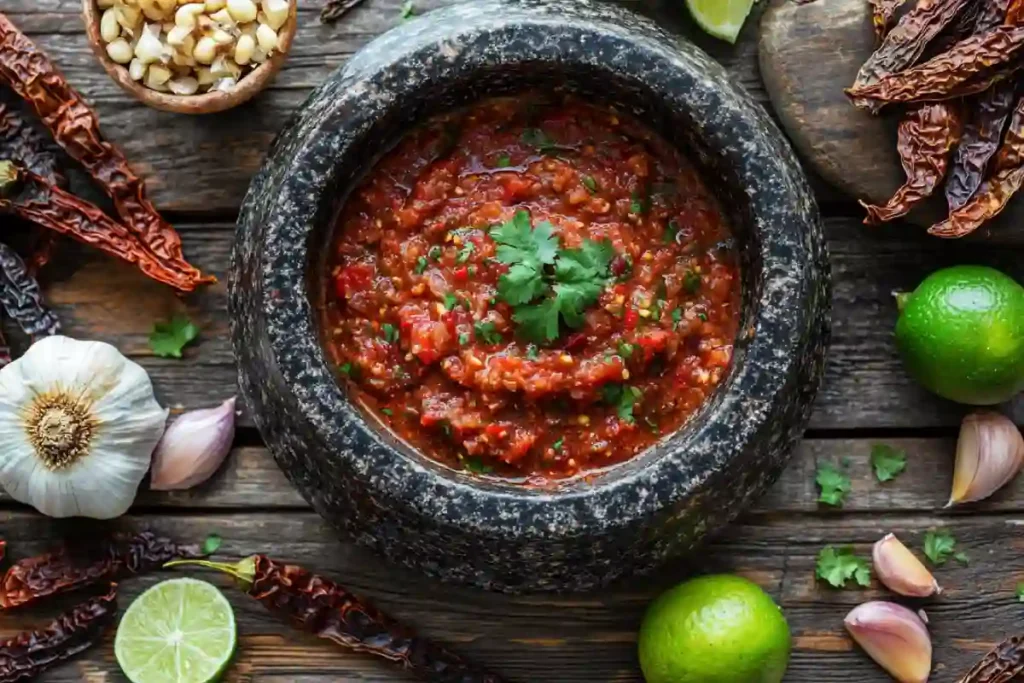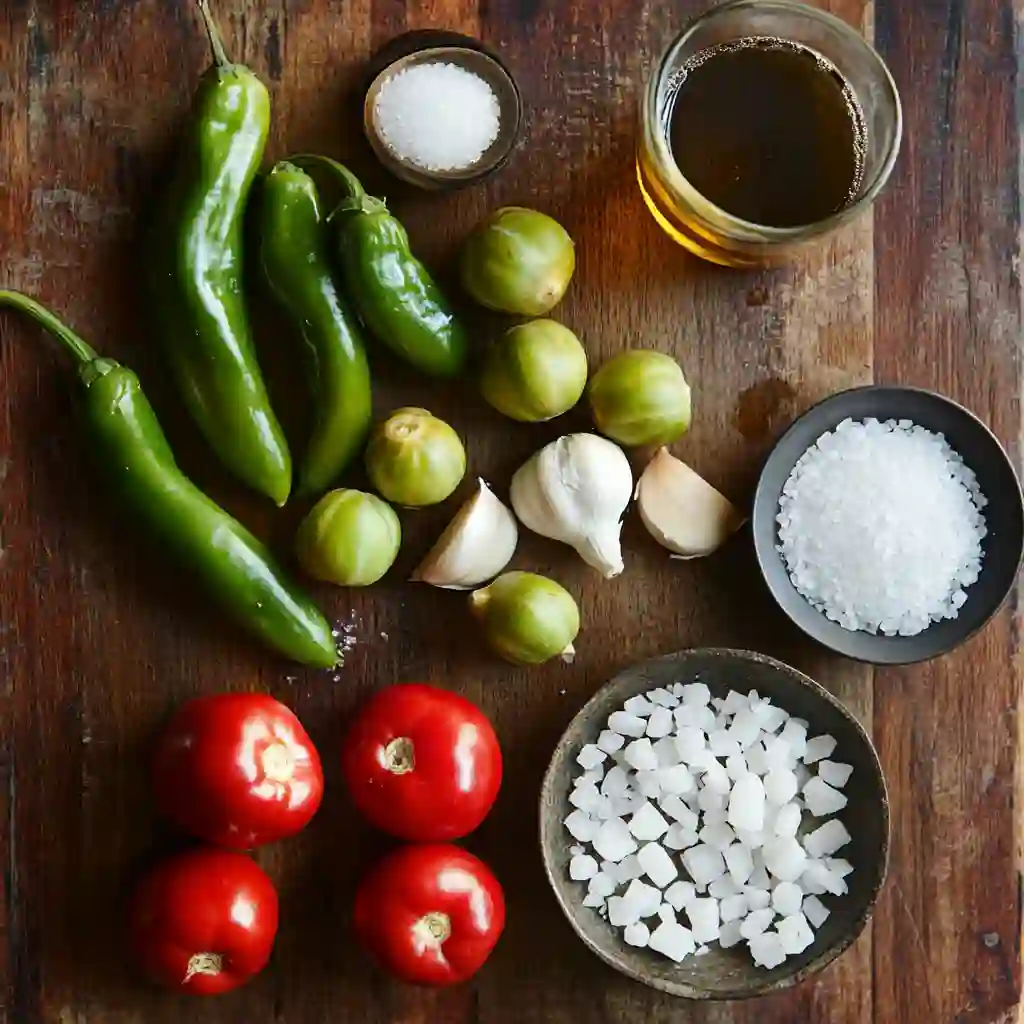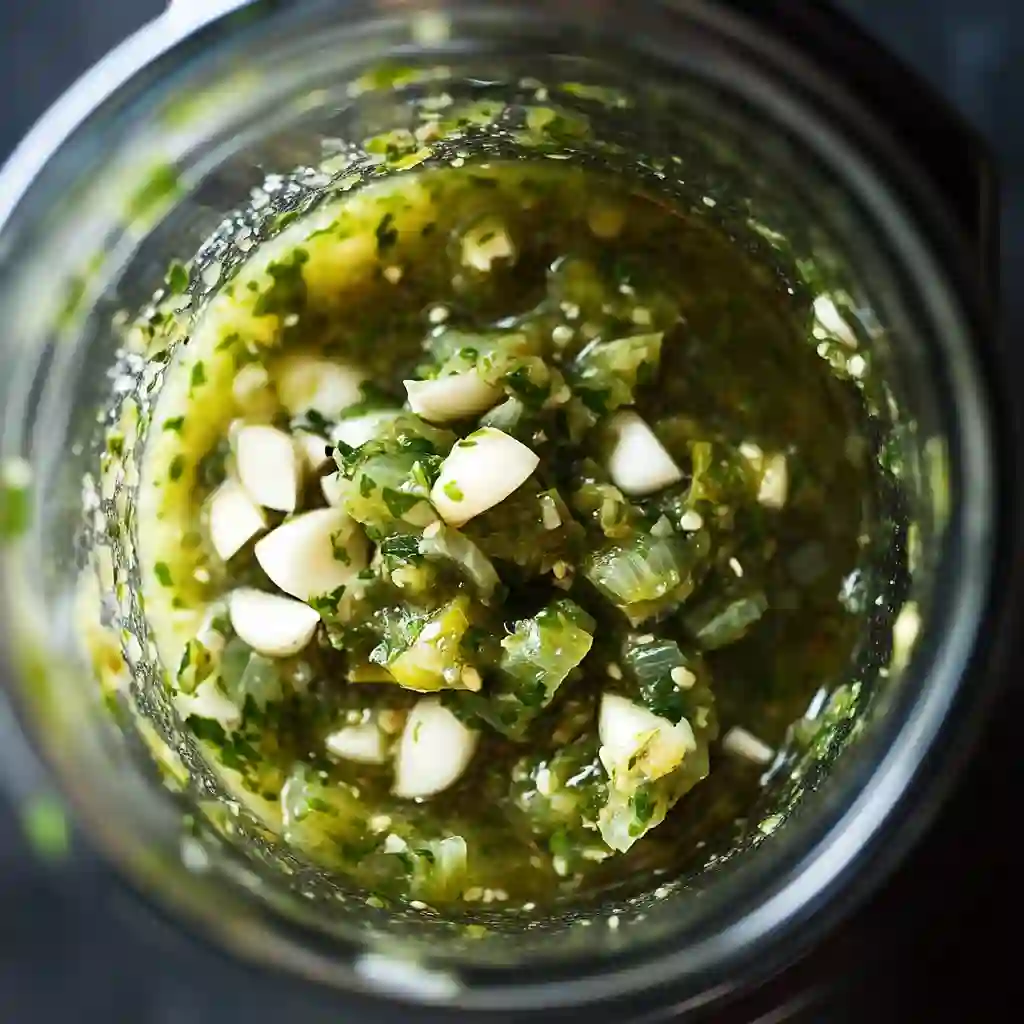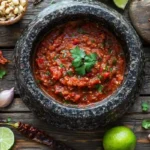
Table of Contents
There’s something quietly captivating about the pasilla pepper—its deep raisin-like aroma, dark wrinkled skin, and earthy soulfulness. It’s the kind of chile that doesn’t scream with heat, but whispers stories of smoke, soil, and slow-roasted magic. This post is all about taking those flavors and crafting a pasilla pepper salsa recipe that’s as bold as it is balanced. Whether you’re spooning it onto roasted veggies or layering it in your next taco night, this salsa brings the kind of complexity that only comes from tradition—and a little time.
The Story & Intro
A Love Letter to Smoke and Spice
Back when I first got serious about plant-based cooking, I spent a fall weekend experimenting with every pepper I could find at the local farmers market. Jalapeños were everywhere, but tucked into a corner basket was something darker, more mysterious. A vendor from southern Oregon handed me a dried pasilla pepper and told me, “It’s like a secret ingredient people forgot.” That night, I made my first pasilla salsa. One taste, and I was hooked—the depth, the smoky finish, the mild heat that lingered just long enough to make you curious.
Since then, this pasilla pepper salsa recipe has become my go-to for everything from cozy rice bowls to summer taco nights. It’s one of those condiments that seems humble on the surface, but completely transforms a dish. And here’s the best part—it’s deceptively simple to make. Just a few ingredients, a little toasting, a quick blend, and suddenly your kitchen smells like something out of Oaxaca.
If you’ve ever made a roasted salsa, you’ll feel right at home. If you haven’t yet, there’s no better place to begin. The pasilla’s subtle smoke pairs beautifully with garlic and a splash of acid, and you don’t need fancy tools—just a skillet, a blender, and a little bit of love. You’ll find that it plays especially well with vibrant sides like this grilled corn and pasilla pepper salad, or even layered over something unexpected like a sweet potato mash.
What Makes This Salsa So Special?
So what exactly is a pasilla pepper? Often confused with ancho or mulato chiles, the pasilla—also known as “little raisin” in Spanish—is the dried version of the chilaca pepper. It’s long, narrow, and nearly black, with flavor notes of dried plum, cacao, and gentle smoke. The heat? Low to moderate. That makes it perfect for salsas where you want complexity, not a fiery punch.
Unlike jalapeños or serranos, which bring sharp, green heat, pasillas are rich and mellow. They’re the kind of chile you toast low and slow, rehydrate with warm water, and blend into a velvet-like base. That’s why they work so beautifully in everything from moles to soups, and of course, salsas.
One thing that elevates this particular pasilla pepper salsa recipe is how it taps into the pepper’s natural bitterness and offsets it with roasted tomatillos or tomatoes. Add a few cloves of caramelized garlic, a touch of vinegar or lime, and salt—and suddenly, you’ve got something far more layered than your average jarred salsa.
If you’re curious about the broader world of pasillas and their variations, take a detour over to the pasilla bajio chili pepper post, where you’ll learn how regional varieties shape flavor and spice differently. It’s a deep dive worth taking if you want to cook intuitively with these beautiful chiles.
From Pepper to Perfect Salsa
There’s a quiet ritual to making pasilla salsa. It’s not complicated, but it asks you to slow down and pay attention—toast the chile just right, blister the garlic, blend with care. In return, you get a salsa that feels like it was handed down. Below is everything you need to craft the perfect smoky pasilla pepper salsa at home, using pantry-friendly, plant-based ingredients.
Ingredients: What You’ll Need

This salsa sticks to the essentials. Each ingredient plays a specific role—no filler, no extras. Here’s the core list:
| Ingredient | Amount |
|---|---|
| Dried pasilla peppers | 2 large (about 1 oz total) |
| Garlic cloves, unpeeled | 3 cloves |
| Tomatillos (or Roma tomatoes) | 4 medium, halved |
| Apple cider vinegar (or lime juice) | 1–2 tsp |
| Salt | ½ tsp, or to taste |
| Filtered water (for soaking and blending) | As needed |
Optional additions: Toasted cumin seeds, fresh cilantro, or a dash of smoked paprika.
Step-by-Step Instructions
Here’s how to transform these simple ingredients into a rich, smoky pasilla salsa in under 25 minutes.
1. Toast the Pasilla Peppers
Wipe the peppers clean with a dry cloth. Using tongs, toast them in a dry skillet over medium heat for about 30 seconds per side, just until they puff slightly and release their aroma. Do not let them burn—they’ll turn bitter. This step unlocks the pepper’s oils and enhances its natural smokiness, as explained in our full pasilla pepper guide.

2. Soak the Peppers
Place the toasted peppers in a bowl and pour hot water over them. Let them soak for about 20 minutes until they’re pliable and soft. Reserve at least ⅓ cup of the soaking liquid for blending. Remove stems and most seeds, but keep some for heat if you like.
3. Roast the Garlic and Tomatillos
Using the same skillet, add the unpeeled garlic and place the tomatillos cut-side down. Roast over medium heat for 5–7 minutes until charred and soft, turning occasionally. You’re aiming for deep browning—it brings out a natural sweetness and depth that balances the pepper’s earthiness.
4. Blend the Salsa
Peel the garlic and place it in a blender along with the rehydrated pasilla pieces, ⅓ cup soaking liquid, roasted tomatillos, vinegar or lime juice, and salt. Blend until smooth but not overly puréed—you want a rustic texture. If the mixture is too thick, stir in a bit more soaking water until it reaches your preferred consistency.

5. Taste and Adjust
This salsa is forgiving. Too tangy? Add a pinch of sugar. Too thick? Add water. Need more heat? Stir in a little of the reserved seeds. You’re looking for a balance between smoke, tang, and umami. Keep it in a sealed jar in the refrigerator for up to one week.
For another smoky twist, you might enjoy the technique used in this pasilla pepper sauce recipe—it layers in additional aromatics like onion and toasted seeds for depth.
Pair It, Store It, Love It
The beauty of this pasilla pepper salsa recipe is that it’s more than just a condiment—it’s a flavor amplifier. With its mild heat, smoky depth, and velvety texture, this salsa works on everything from casual bowls to celebratory spreads. It elevates without overwhelming. Let’s talk about how to enjoy it and how to keep it tasting amazing.
Serving Ideas: From Street Tacos to Grain Bowls
Pasilla pepper salsa is incredibly adaptable. Whether you’re spooning it over roasted vegetables or spreading it on warm tortillas, it plays well with just about everything.
1. Over Roasted Veggies
Spoon over charred carrots, potatoes, or grilled zucchini. The smoky notes complement sweet, earthy vegetables.
2. On Tacos, Naturally
This salsa makes black bean tacos or jackfruit carnitas sing. Its balanced heat lets you build big flavors without overpowering the filling.
3. Swirled into Grain Bowls
Layer it over quinoa or brown rice bowls with avocado, sautéed greens, and tofu. It adds acid, spice, and body.
4. As a Dip for Chips or Crudités
Try it with blue corn chips or even roasted sweet potato rounds. Add it alongside carrot pasilla pepper soup for a smoky appetizer duo.
5. On Toast or Flatbread
Use as a spread for hummus toasts or drizzle over grilled flatbread with roasted veggies and seeds.
Pasilla’s depth really shines when combined with ingredients like fire-roasted corn or charred peppers. This grilled corn and pasilla pepper salad makes a perfect sidekick to your salsa, delivering crunch, sweetness, and contrast.
And if you’re curious about the source of that smoky flavor, revisit our full pasilla pepper post to learn how drying techniques impact aroma and depth.
Storage Tips: Make It Last
One of the best things about pasilla salsa? It stores beautifully, and the flavor deepens over time. Here’s how to make it work for your week—or month.
Fridge:
- Store in a glass jar or airtight container
- Keeps for up to 7 days
- Stir before using, as it may separate slightly
Freezer:
- Portion into ice cube trays or small containers
- Freeze for 2–3 months
- Thaw and stir before using—it retains flavor well
Flavor Matures Over Time
The vinegar and garlic mellow into the smoky chile base, giving it even more balance by day two or three. Ideal for batch prep.
The Character of Pasilla in Your Kitchen
Pasilla peppers do more than flavor a salsa—they shape the entire experience of a dish. Once you’ve worked with them a few times, their rich personality starts to feel essential in your kitchen. This section digs into how they elevate recipes and why they’ve earned a dedicated place in the plant-based pantry.
Flavor That Builds in Layers
Unlike sharper chiles that bring aggressive heat, pasillas offer a warm smokiness and subtle sweetness. Their flavor is often described as raisin-like, slightly bitter, with undertones of dried fruit and cacao. When dry-toasted and soaked, the peppers open up into something soft and complex—ideal for blending into thick salsas or thinner sauces.
In this salsa, the pasilla blends with roasted garlic, acidic tomatillos or vinegar, and a pinch of salt to become something bold yet balanced. It’s that layered quality that makes it so versatile. A spoonful brings heat, yes—but also depth, smoke, and structure. This is exactly why pasilla is a star in other sauces too, like this pasilla pepper sauce recipe.
Want to understand the deeper chemistry of why pasillas taste the way they do? The Serious Eats dried chile guide offers a fantastic breakdown of chile flavor profiles and how to use them in modern and traditional kitchens.
A Mild Heat with Deep Roots
For those concerned about spiciness, pasillas fall on the gentler side of the scale. While a jalapeño can reach up to 8,000 Scoville Heat Units, a pasilla usually ranges between 1,000 and 2,500. That means it’s hot enough to stand out, but still mild enough to blend freely into dishes for children or spice-sensitive palates.
This mildness makes pasilla ideal for layering. It’s a key chile in Mexican moles and soups where its low heat lets other ingredients speak. In salsa, it delivers more umami than fire, making it perfect for everything from tacos to soups to marinades.
If you’re curious about how these peppers are grown, harvested, and traditionally used in Mexican cuisine, our pasilla pepper guide offers the full story—origin, cultural roots, flavor notes, and tips for sourcing.
FAQs
Can pasilla peppers be used in salsa?
Yes—pasilla peppers are ideal for salsa. Their earthy flavor and mild heat make them a fantastic base when combined with roasted garlic, tomatillos, and vinegar.
What can I make with pasilla peppers besides salsa?
They’re great in moles, soups, stews, and even rich sauces. They blend well in dishes like carrot pasilla pepper soup or used as the star in pasilla pepper sauce.
What ingredients make up traditional pasilla sauce?
Commonly: rehydrated pasilla peppers, garlic, vinegar or lime, roasted onion or tomato, and salt. You’ll find a base version in our featured salsa recipe.
Is pasilla milder than jalapeño?
Yes. Jalapeños rate up to 8,000 SHU, while pasilla typically ranges between 1,000–2,500 SHU. That makes it smoky and rich without overpowering heat.
Conclusion
This pasilla pepper salsa recipe isn’t just about flavor—it’s about story, culture, and the kind of everyday magic you can create in your kitchen. Smoky, subtle, and packed with character, it’s the kind of condiment you’ll find yourself making again and again. Whether you’re spooning it over tacos or building entire meals around its deep flavor, pasilla salsa proves that plant-based cooking doesn’t need to be complicated to be bold.
Print
Pasilla pepper salsa recipe
- Total Time: 25 minutes
- Yield: 1.5 cups 1x
- Diet: Vegan
Description
A smoky, mildly spicy salsa made from rehydrated pasilla peppers, roasted garlic, and tangy tomatillos. Perfect for tacos, grain bowls, and dipping.
Ingredients
2 dried pasilla peppers
3 garlic cloves (unpeeled)
4 tomatillos (or 2 Roma tomatoes), halved
1–2 tsp apple cider vinegar or lime juice
½ tsp sea salt (or to taste)
⅓ cup pasilla soaking liquid (reserved after soaking)
Filtered water as needed
Instructions
1. Toast pasilla peppers in a dry skillet over medium heat until they puff and release aroma (30–45 seconds per side).
2. Soak toasted peppers in hot water for 20 minutes until soft. Reserve ⅓ cup soaking liquid. Remove stems and seeds.
3. In a skillet, roast unpeeled garlic and halved tomatillos (cut side down) until charred and soft.
4. Peel garlic and add to a blender with softened pasilla, tomatillos, vinegar or lime juice, salt, and soaking liquid.
5. Blend until smooth but rustic. Add more water if needed to reach desired consistency.
6. Taste and adjust seasoning. Serve immediately or chill to allow flavors to deepen.
Notes
– Flavor improves after 24 hours in the fridge.
– Freeze in ice cube trays for single servings.
– Try adding fresh cilantro or cumin for variations.
– Great on tacos, bowls, grilled veggies, or sandwiches.
- Prep Time: 10 minutes
- Cook Time: 15 minutes
- Category: Condiment
- Method: Blending
- Cuisine: Mexican
Nutrition
- Serving Size: 2 tablespoons
- Calories: 18
- Sugar: 1g
- Sodium: 115mg
- Fat: 0.1g
- Saturated Fat: 0g
- Unsaturated Fat: 0.1g
- Trans Fat: 0g
- Carbohydrates: 4g
- Fiber: 1g
- Protein: 0.5g
- Cholesterol: 0mg
Keywords: pasilla pepper salsa recipe, smoky salsa, pasilla salsa
